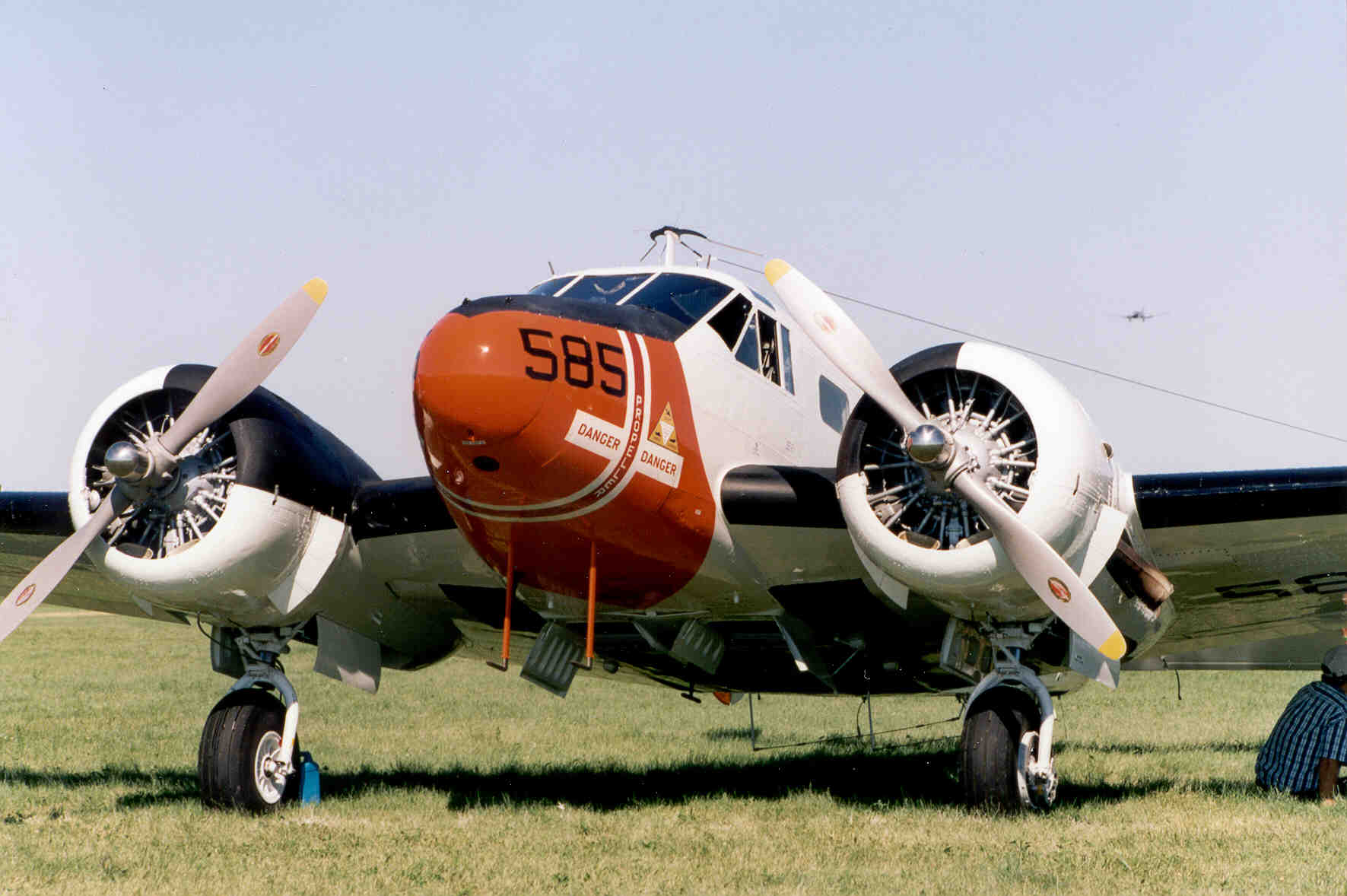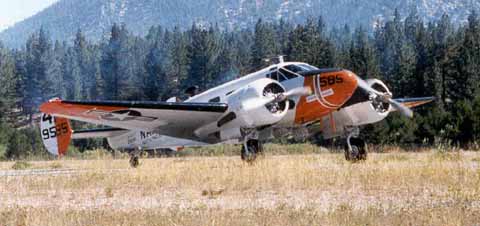Beechcraft RC-45J, N75018
Call or email for info on how to acquire this bird



I purchased the aircraft from a museum where it had been stored since she came out of the Navy. Inside this grand old lady is all of the equipment and gear that she carried when she was in service. When I first crawled in through the entry door it was truly like stepping back in time. The instrument approach plates were still there, as was a chart showing a photo mapping mission from the Florida area. Even the emergency escape cards and instructions were still stowed.The only things missing were the aerial cameras and the parachutes.
This beech entered military service in 1944 to train Navigators. After the war she was overhauled and re configured as an aerial photography trainer. She trained student photographers for the Navy until she was retired in 1972 to the bone yard at Davis Monthan Airfield in Tucson, Arizona.
I acquired this Beech in 1996 and I transported her home on a trailer that I built especially for hauling Twin Beech's.
A lot of work went into this Beech to get her back into the air. I do not consider this a restoration, as many people have called it. The word resurrection is a more accurate term. Finding a military stock Beech these days is next to impossible. The very first thing people seem to do when they first get a stock military Beech is to rip out all of the old radio and navigation equipment and throw it away. This practice is almost universal among the surviving aircraft these days. I know of several RC-45J's that have had this same fate. One owner now is actually trying to find the equipment that he threw out a few years ago. This is why this RC-45J is such a rare find. Not only was the original gear still there when I got the aircraft, but it remains there and is operational as well.
I wanted to keep this Beech as original as possible to preserve its rich history. Safety is of course of paramount importance, so I went through every system and brought them up to current airworthiness standards. The airframe was cleaned and inspected. Every rubber hose was changed. All damage repaired. All systems were rigged and tested. The brakes and cockpit glass were replaced with new old stock parts. The airframe was in great shape because the US Navy did a great job of corrosion protection. The reason why the interior was in such great shape can be explained by the photo above. The white and black covering over the windows is called Spraylat, which is used by the military to protect the aircraft when it is in storage. The Spraylat kept the interior safe from the harsh sunlight in the Arizona desert.

It has been my experience that once you go through all of the systems and clean lube and adjust everything in a Twin Beech you have a very reliable aircraft. This Beech has reinforced that theory. There isn't anywhere I wouldn't go with my family in this fun Beech.
There are a few modifications that I have done to this aircraft for safety and preservation. The biggest mod is the spar strap. I have installed an Aerospace products strap which is flush and unobtrusive. The strap fits beautifully around the camera bay doors. Another mod was installed to protect the engines. I have put on oil filters to keep the engine clean internally. It has worked well since the oil that comes out of the engine still has a translucence to it in contrast to the jet black oil that oozes out of most radials.
I wanted to preserve the paint and restore the original finish so I took hundreds of pictures of the outside. I used clear Mylar sheets and traced every marking on the airframe. The rivet heads and skin laps were traced as well so I could find the exact location when re applying the markings. I used a pushpin to make a hole at the corner of every marking and every curve. Then I stripped the paint and applied the new white and orange base paint that was mixed to match the original MIL specifications. The Mylar sheets were then put back up and aligned with the rivet and skin laps. A Sharpie was used to mark thousands of dots outlining the markings. Fine line tape to the dots was used to create the masking for the markings. The entire aircraft was painted without the use of a ruler, and every marking is within a millimeter of its original location. All of the original inaccuracies were reproduced just as they were straight from the Navy paint shop. I think that the paint scheme is striking, and she certainly attracts attention wherever she goes. She won the Most Authentic Warbird award at the EAA Airventure 1999.
This is a picture of this exact RC-45J when she was still in the Navy in September of 1970.
The RC-45J was specially configured for Aerial Photography with several modifications. These modifications are unique to this model Twin Beech and are not only functional but are fun as well. The biggest modification is the camera bays located just aft of the cockpit. These bays have retractable doors that cover the optical glass (these doors are visible in the photo at the top of this page). You can open these doors from the cockpit or main cabin and have a great view of the scenery below. There is an optical viewfinder in the nose of the aircraft with a scope mounted in front of the co pilot. This scope looks right out the nose and you can select either forward or downward views.
The original electronic gear includes a full compliment of radio equipment. One thing that I find fascinating is that almost all of the radios are of WWII vintage even though the aircraft was still flying in the Navy until 1972. The famous ARC-5 radio set (three receivers and two transmitters) is fully operational. I have tuned in short wave stations from around the world on these receivers. Flying at night between two purring Pratt & Whitneys with all of the red cockpit lights on, tuning a radio with the coffee grinder style crank and listening in on a foreign radio station that fades in and out puts you in a real time warp. This is just one of six different radio sets in the Beech, many of which are quite usable for navigation and practice approaches. The ARN-30 is one of the first VOR/Localizer sets. I was floored when I cranked in the localizer frequency to the Livermore ILS and the needle came alive and worked perfectly.
The P-1 Auto Pilot on board is the same one found in the A-4 Skyhawk, the AD Skyraider, Albatross, and many other aircraft. Amazingly enough, this three axis autopilot still works.
I have been flying this Beech at air shows and open houses since 1999. I have also been selling rides in her which has been a good business. In her present shape she is a great and reliable bird. I haven't missed a show or a ride except for a flat tail wheel tire in Grass Valley a few years ago.

Photos by Paul Koskela, Thank you Paul!
This bird has since been sold and travelled into Canada for her new owner many years ago. She has had some accidents and is not quite as she looks on this webpage anymore. However, she's not done flying and could use a new owner to get her back in the air again. If anyone is interested in taking on a well worth it project, please contact us and we can fill you in on the details and give you an idea of what it will take, money and time, to make her good as new.